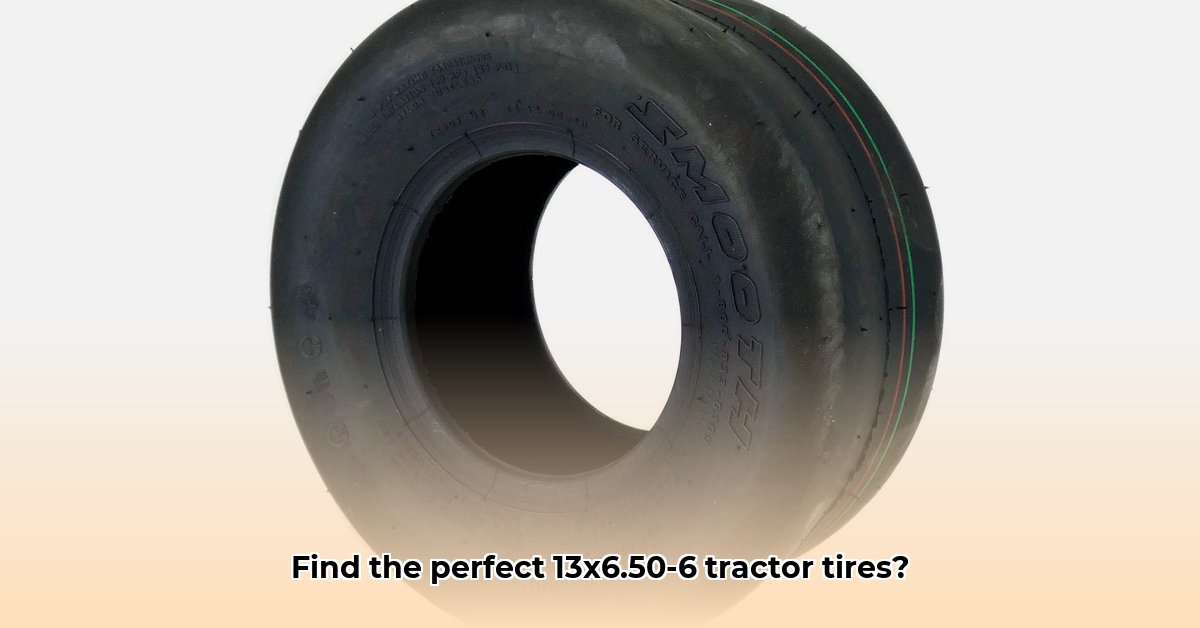
Choosing the right tires for your tractor is more than just a maintenance task; it's a crucial step towards sustainable farming. This guide focuses on 13x6.50-6 tires, a common size for smaller tractors, and how selecting the appropriate ones can significantly impact your farm's efficiency and environmental footprint. We'll explore their features, benefits, and provide actionable steps for making an informed decision. For more information on tire pricing, check out tractor tire costs.
Understanding 13x6.50-6 Tractor Tires: Size Matters
The 13x6.50-6 tire size is frequently found on smaller tractors and implements. This size often offers a good compromise between maneuverability and traction. However, the optimal tire for your needs depends on several factors. Just as you wouldn't wear hiking boots for a marathon, the right tire choice depends on your specific farming conditions.
Sustainable Farming with 13x6.50-6 Tires: The Environmental Impact
Sustainable agriculture prioritizes soil health and minimizes environmental impact. Surprisingly, tire selection plays a significant role in achieving these goals. Proper tire choice leads to:
- Reduced Soil Compaction: Minimizes soil damage, improving water infiltration and root growth. Isn't healthy soil the foundation of successful farming?
- Improved Fuel Efficiency: The right tires reduce slippage, leading to greater fuel economy and lower operating costs. How much fuel could you save annually with optimized tires?
- Lower Chemical Use: Healthy soil leads to healthier plants, reducing the necessity for chemical fertilizers and pesticides. What is the potential for chemical reduction on your farm?
Selecting the Right 13x6.50-6 Tire: A Personalized Approach
Several key factors determine the ideal 13x6.50-6 tire for your operation. Let's break down the essential considerations:
- Soil Type: Clay soils require different traction than sandy soils. Consider the texture and moisture retention of your soil.
- Terrain: Hilly terrain demands more aggressive treads for better grip, preventing slippage, especially in wet conditions. Flat, level fields offer more flexibility.
- Tasks: Tilling requires different tires than spraying. Consider the weight and functionality of your equipment.
- Weight Capacity: Always ensure the tire's weight capacity exceeds your machinery's weight to avoid premature wear and potential damage.
13x6.50-6 Tire Comparison: Finding the Best Fit
The following table exemplifies tire characteristics. Remember, these are illustrative examples, and actual performance may vary depending on multiple factors. Always refer to manufacturer specifications.
| Tire Brand (Example) | Key Features | Pros | Cons | Ideal Use Cases |
|---|---|---|---|---|
| Example Brand A | Aggressive tread, heavy-duty construction | Excellent traction in mud and challenging terrain. | Might be less fuel-efficient on paved surfaces. | Heavy-duty tasks, muddy or hilly terrain |
| Example Brand B | Smooth tread, good wear resistance | Long lifespan, comfortable ride, good fuel economy. | Less aggressive traction in mud or loose soil. | General use, transport, paved or hard surfaces |
Tire Lifespan and Sustainability: Long-Term Considerations
Proper tire care significantly extends their lifespan, minimizing waste. Regular pressure checks and responsible recycling practices are crucial for sustainability. Underinflation accelerates wear and reduces fuel efficiency; overinflation can also damage the tires.
Actionable Steps: A Guide to Choosing and Maintaining Your Tires
Follow these steps to ensure optimal tire performance and sustainability:
- Assess Farm Needs: Analyze your soil, terrain, and typical farming activities.
- Consult Tractor Manual: Verify tire size and load rating recommendations.
- Compare Tire Options: Research different brands and models available at Tractor Supply Co.
- Purchase and Installation: Choose suitable tires and consider professional installation for optimal balance.
- Regular Maintenance: Monitor tire pressure and tread depth regularly.
By prioritizing sustainable tire choices, you contribute significantly to healthier soil, improved efficiency, and a reduced environmental footprint. Remember: soil health underpins the success of sustainable agriculture.